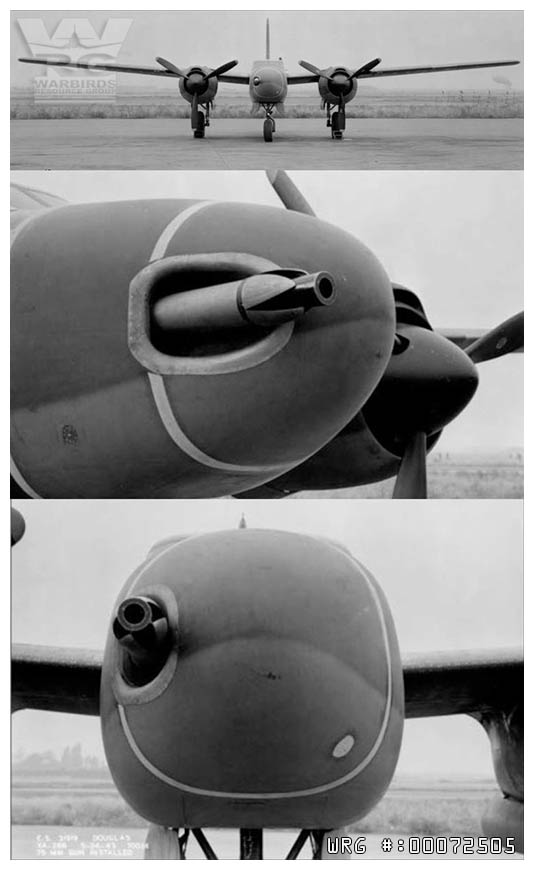A-26 Invader with a 75mm???
Tue Feb 18, 2020 1:19 pm
Haven't seen this configuration before for an A-26 Invader. Looks to be a 75mm with a "tulip" muzzle guard. I've see this set up on the B-25 Mitchell but not the Invader. I also thought the spinners were interesting as well.

Re: A-26 Invader with a 75mm???
Tue Feb 18, 2020 1:37 pm
I've seen these before. Dunno if it actually flew, or even if that's a real cannon in there or just a mockup or 3D napkindoodle.
Re: A-26 Invader with a 75mm???
Tue Feb 18, 2020 3:27 pm
Re: A-26 Invader with a 75mm???
Tue Feb 18, 2020 5:45 pm
If you have access to McDonnell Douglas Aircraft since 1920; Volume I, this is discussed on pages 339-341 with a photo on page 340 of both a 75mm cannon (starboard) and 37mm cannon (port). Basically the discussion is how the AAF instructed Douglas as late as 18 July, 1942, to install 75mm cannon in all 500 aircraft on order. It goes on to list a number of other gun installation configurations. The following is a quote.
Order was restored in the midst of chaos only at the end of 1944 when it was finally decided that the Long Beach plant would continue to produce exclusively A-26Bs with the unglazed-noses housing six or eight 0.50-in machine-guns (earlier this plant had also built five A-26Cs with the transparent nose) whilst, starting in January 1945, the Tulsa plant would discontinue production of A-26Bs to concentrate all of its efforts on manufacturing A-26Cs.
On page 343 this is the entry for the XA-26B-DE:
Last Invader built in the El Segundo plant, this aircraft (41-19588) was the attack version prototype and was fitted with an unglazed nose housing a forward-firing 75 mm cannon. The crew consisted of pilot and gun-loader/navigator seated side by side in the forward cockpit and a gunner in the rear cockpit.
Randy
Order was restored in the midst of chaos only at the end of 1944 when it was finally decided that the Long Beach plant would continue to produce exclusively A-26Bs with the unglazed-noses housing six or eight 0.50-in machine-guns (earlier this plant had also built five A-26Cs with the transparent nose) whilst, starting in January 1945, the Tulsa plant would discontinue production of A-26Bs to concentrate all of its efforts on manufacturing A-26Cs.
On page 343 this is the entry for the XA-26B-DE:
Last Invader built in the El Segundo plant, this aircraft (41-19588) was the attack version prototype and was fitted with an unglazed nose housing a forward-firing 75 mm cannon. The crew consisted of pilot and gun-loader/navigator seated side by side in the forward cockpit and a gunner in the rear cockpit.
Randy
Re: A-26 Invader with a 75mm???
Wed Feb 19, 2020 2:29 pm
One of the guys that was part of the Ranger Squadron, back when it formed, had been part of the flight test crew for the 75 on the Invader. Told an interesting story or two about some the early test flights down in Florida.
Re: A-26 Invader with a 75mm???
Wed Feb 19, 2020 3:11 pm
Re: A-26 Invader with a 75mm???
Wed Feb 19, 2020 4:40 pm
Re: A-26 Invader with a 75mm???
Wed Feb 19, 2020 7:08 pm
^^^Bottom left corner: Looks like B-17G 42-107181 making a stop at Wright on its way across the pond; this would date the picture in mid-April 1944. '181 served with several different groups/squadrons before returning to the States and ending its days at Kingman.
Re: A-26 Invader with a 75mm???
Sun Mar 01, 2020 11:45 pm
Here's another cannon-nosed A-26B that looks like it suffered an accidental gear retraction at Barksdale Field on July 18, 1944:
https://www.ebay.com/itm/BARGAIN-LOT-Po ... SwoXZeWIq0
Serial is actually 43-22254; it's wrong on all the photos in the lot.
https://www.ebay.com/itm/BARGAIN-LOT-Po ... SwoXZeWIq0
Serial is actually 43-22254; it's wrong on all the photos in the lot.




